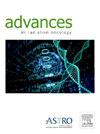Microboost in Localized Prostate Cancer: Analysis of a Statewide Quality Consortium
IF 2.2
Q3 ONCOLOGY
引用次数: 0
Abstract
Purpose
Prospective trials have reported isotoxicity and improved oncologic outcomes with external beam radiation therapy (EBRT) microboost to a dominant intraprostatic lesion. There is often variability in the rate of adoption of new treatments, and current microboost practice patterns are unknown. We leveraged prospectively collected data from the multicenter Michigan Radiation Oncology Quality Consortium to understand the current state of microboost usage for localized prostate cancer.
Materials and Methods
Men with intermediate- and high-risk prostate adenocarcinoma treated with curative-intent radiation between October, 26, 2020, and June, 26, 2023, were included across 26 centers. Demographic-, tumor-, and treatment-related data along with DICOM files were prospectively collected. Microboost intent was prospectively documented and DICOM-confirmed. Multivariable analyses were used to evaluate associations with microboost receipt, and mixed-effects modeling evaluated facility-level variation.
Results
Most patients received EBRT without brachytherapy (71%, n = 524/741). Of those, a minority received an EBRT microboost (10%, n = 53/524) at a subset of sites (27%, n = 7/26), without a change in rate over the study period (P = .62). Grade group 4/5 (odds ration [OR] = 2.35; 95% confidence interval [CI]: 1.02-5.28), magnetic resonance imaging planning (OR = 6.34; 95%CI: 2.16-27.12), and fiducial marker/rectal spacer placement (OR = 2.59; 95% CI: 1.14-6.70) were associated with microboost use. Significant facility-level variability was present (minimum 0%; 95% CI: 0.0-10.7 to maximum 71%; 95% CI: 55.5-83.2, unadjusted, P < .0001). Median boost volume was 20.7cc, and median boost D98% was 94.4 EQD2Gy. Compared with non-microboost cases, intermediate doses to rectum in the microboost cohort were increased (eg, V20Gy [EQD2] of 53.8% vs 36.5%, P = .03). However, the proportion exceeding NRG/RTOG bladder/rectal constraints was low and not significantly different between cohorts.
Conclusions
Despite prospective data demonstrating its benefit, EBRT microboost was used within a diverse statewide quality consortium in only 10% of cases at 27% of sites with significant facility-level heterogeneity. Concerted efforts are required to understand current barriers to microboost utilization, and results from trials such as PIVOTALboost (ISRCTN80146950) are eagerly awaited.
局部前列腺癌的微促进治疗:全州质量联合会分析
目的 有前瞻性试验报告称,对睾丸内占位性病变进行体外放射治疗(EBRT)微增强治疗可改善等毒性和肿瘤治疗效果。新疗法的采用率往往存在差异,目前的微增强实践模式尚不清楚。我们利用从多中心密歇根放射肿瘤学质量联合会(Michigan Radiation Oncology Quality Consortium)收集的前瞻性数据,来了解微增强治疗局部前列腺癌的使用现状。材料与方法纳入了 26 个中心在 2020 年 10 月 26 日至 2023 年 6 月 26 日期间接受治愈性放射治疗的中危和高危前列腺腺癌患者。前瞻性地收集了人口统计学、肿瘤和治疗相关数据以及 DICOM 文件。前瞻性地记录了微推进意向并经 DICOM 确认。多变量分析用于评估接受微增强治疗的相关性,混合效应模型评估了医疗机构层面的差异。其中,少数患者在部分医疗机构(27%,n = 7/26)接受了 EBRT 微增强治疗(10%,n = 53/524),但在研究期间治疗率没有发生变化(P = .62)。4/5级组(赔率 [OR] = 2.35;95% 置信区间 [CI]:1.02-5.28)、磁共振成像规划(OR = 6.34;95%CI:2.16-27.12)和靶标/直肠间隔放置(OR = 2.59;95% CI:1.14-6.70)与微助推器的使用有关。设备水平存在显著差异(最小 0%;95% CI:0.0-10.7,最大 71%;95% CI:55.5-83.2,未调整,P < .0001)。中位增强量为 20.7cc,中位增强 D98% 为 94.4 EQD2Gy。与非微量推进病例相比,微量推进队列中直肠的中间剂量有所增加(例如,V20Gy [EQD2] 为 53.8% vs 36.5%,P = .03)。结论尽管前瞻性数据显示了EBRT微增强的益处,但在一个多样化的全州质量联盟中,仅有10%的病例在27%的医疗机构中使用了EBRT微增强,且医疗机构间存在显著的异质性。我们需要齐心协力了解目前微量促进剂使用的障碍,并热切期待 PIVOTALboost(ISRCTN80146950)等试验的结果。
本文章由计算机程序翻译,如有差异,请以英文原文为准。
求助全文
约1分钟内获得全文
求助全文
来源期刊

Advances in Radiation Oncology
Medicine-Radiology, Nuclear Medicine and Imaging
CiteScore
4.60
自引率
4.30%
发文量
208
审稿时长
98 days
期刊介绍:
The purpose of Advances is to provide information for clinicians who use radiation therapy by publishing: Clinical trial reports and reanalyses. Basic science original reports. Manuscripts examining health services research, comparative and cost effectiveness research, and systematic reviews. Case reports documenting unusual problems and solutions. High quality multi and single institutional series, as well as other novel retrospective hypothesis generating series. Timely critical reviews on important topics in radiation oncology, such as side effects. Articles reporting the natural history of disease and patterns of failure, particularly as they relate to treatment volume delineation. Articles on safety and quality in radiation therapy. Essays on clinical experience. Articles on practice transformation in radiation oncology, in particular: Aspects of health policy that may impact the future practice of radiation oncology. How information technology, such as data analytics and systems innovations, will change radiation oncology practice. Articles on imaging as they relate to radiation therapy treatment.
 求助内容:
求助内容: 应助结果提醒方式:
应助结果提醒方式:


